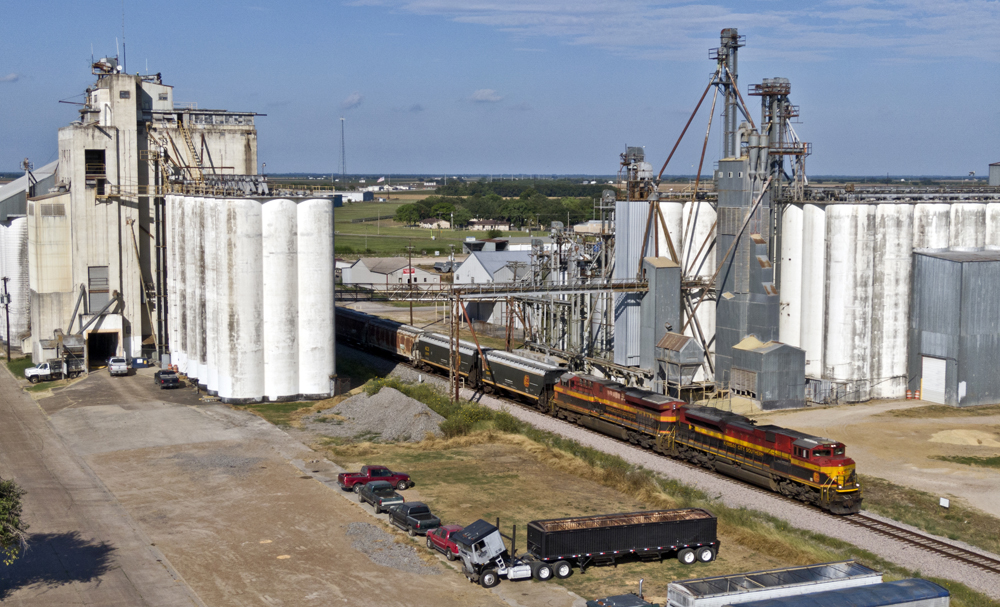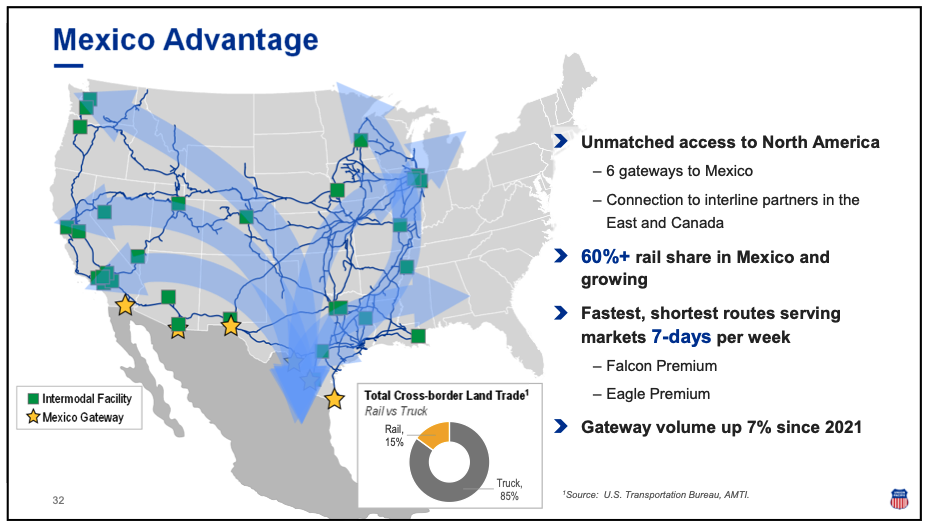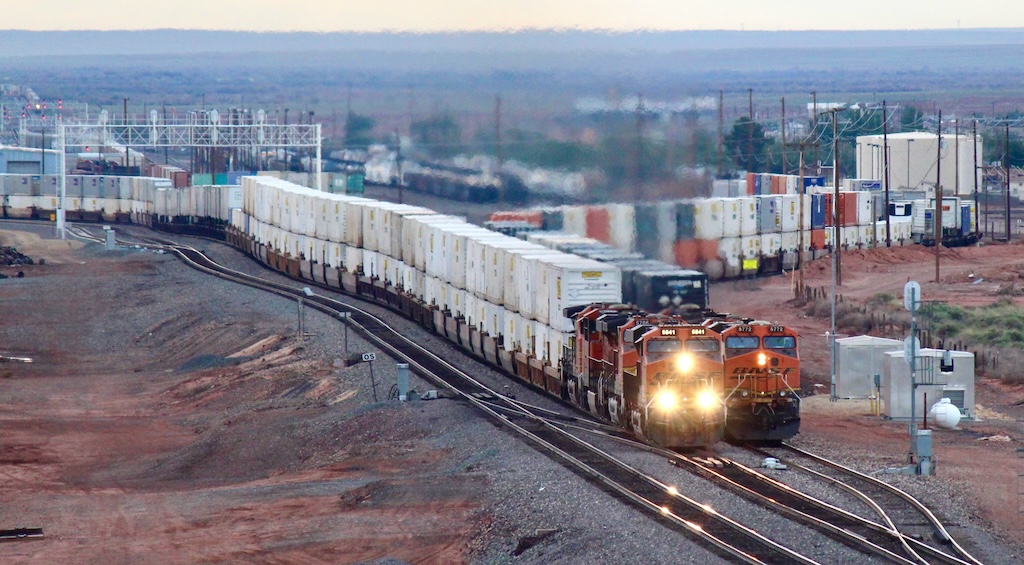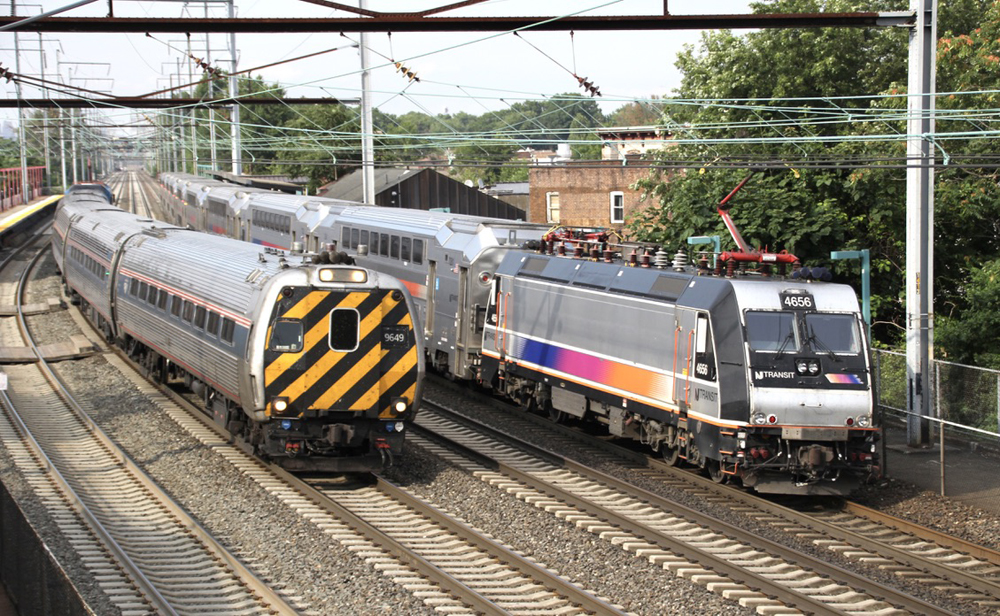
President-elect Donald Trump’s plans to impose 25% tariffs on goods imported from Mexico and Canada could have a chilling impact on cross-border rail traffic, which has been one of the few sources of volume growth for North American Class I railroads.
Trump announced the plans last night in a social media post, saying that he would sign an executive order on Jan. 20, 2025, his first day in office. The order also would hit goods produced in China with an additional 10% tariff.
In his 2016 campaign, Trump called NAFTA the worst trade agreement ever and pledged to rip it up. Instead, the treaty was modernized and given a new name, the United States-Mexico-Canada Agreement. It went into effect in July 2020.
Canadian Pacific Kansas City — the only railway to link Canada, the U.S., and Mexico — faces the most risk if the tariffs are imposed.

In 2023, some 41% of CPKC’s $8.9 billion in revenue was tied to cross-border trade: 16% from Canada to the U.S.; 12% from the U.S. to Mexico; 6% U.S. to Canada; 5% Mexico to the U.S.; and 2% for traffic moving between Mexico and Canada.
CPKC is relying on a combination of trade growth, single-line service, and market share gains from trucks and other railroads to help pay for the 2023 $31 billion merger of Canadian Pacific and Kansas City Southern.
“In spite of all this talk about tariffs, these three countries have never needed each other more,” CPKC CEO Keith Creel told the RailTrends conference earlier this month, before Trump put particulars around his plans for tariffs on imports from Canada and Mexico.
Creel noted that “there was a lot of aggressive rhetoric” about North American trade after Trump was elected in 2016. Yet while USMCA was being negotiated, trade grew 20%, Creel says.
And since the pandemic hit in 2020, manufacturers and retailers have been trying to diversify their supply chains, which has included near-shoring of manufacturing to Mexico.
“How do you unwind that,” Creel says, “and why would you?”

Canadian National is not far behind CPKC in its dependence on North American trade. Some 32% of its $11.9 billion in 2023 revenue was tied to U.S.-Canada cross-border traffic.
CPKC and CN’s cross-border traffic includes metals and minerals, forest products, petrochemicals and plastics, and auto parts and finished vehicles.
Mexico is an important traffic source for Union Pacific, the only railroad to serve all six U.S.-Mexico gateways. In 2023, 11% of the railroad’s volume — or roughly 891,000 loads — is tied to Mexico.
UP considers cross-border traffic to be an important source of traffic growth. Last year, UP’s Mexico cross-border traffic was 59% intermodal and automotive, 21% bulk (mostly grain), and 20% industrial products.
Automotive, beer and beverages, and intermodal shipments represent 86% of northbound loads from Mexico, UP says. Southbound shipments primarily consist of auto parts, intermodal shipments, agricultural products and metals.

BNSF Railway is far less dependent on Mexico, which represents just 3.8% of its overall volume, a railway spokesman says. That translates into 342,000 annual loads. Cross-border traffic to and from Canada represents another 4% of BNSF’s overall volume.
The eastern railroads — CSX and Norfolk Southern — are less dependent on Mexico traffic, but they nonetheless see Mexico as a growth market, particularly for automotive and intermodal business. CPKC and CSX, for example, are banking on growth in intermodal, automotive, and forest products traffic through their new Alabama interchange via the former Meridian & Bigbee Railroad.
Cherilyn Radbourne, an analyst with TD Securities, says the Mexico market represents “a meaningful proportion” of the $1.5 billion in revenue synergies that CPKC is targeting through 2028.
“In the short term, we could see a volume benefit as shipments are pulled forward to get ahead of the proposed tariffs,” she says. “Beyond that, we would expect cross-border volumes to be negatively impacted by increased tariffs.”
Independent analyst Anthony B. Hatch says the negative impact of Trump’s trade policies will far outweigh any regulatory changes that would benefit the railroad industry.
If Trump’s tariffs ignite a trade war with Mexico and Canada, they are likely to reciprocate with tariffs of their own on U.S. products that they import. Mexican President Claudia Sheinbaum said Mexico would impose tariffs on U.S. goods if Trump goes ahead with his plans.
“In any trade war scenario, every country knows that the U.S. is most vulnerable on ag,” Loop Capital Markets analyst Rick Paterson said at the RailTrends conference. “You maximize the pain for U.S. farmers, then let the ag lobby do your work for you in terms of nagging the administration for a change in trade policy.”
Jason Miller, a supply chain professor at Michigan State University, says the auto industry will be disproportionately affected by tariffs, which would affect $200 billion worth of parts and finished vehicles that cross the borders annually.
Some 70% of the crude oil that the U.S. imports comes from Mexico and Canada, Miller notes, which would raise gasoline prices.














Folks, this is a disingenuous article in that is serves a purpose but is not supported by the facts. Trump actually said that if Mexico and Canada didn’t do a better job of controlling their borders with the US and stop the flow of illegal aliens and the accompanying import of illegal drugs, ie, Fentanyl, THEN he would impose the aforementioned 25% tarrifs on Mexican/Canadian goods. He is using tarrifs as leverage and it is a good strategy. Already Trudeau (Canada) and Scheinbaum (Mexico) have agreed to talks to negotiate a solution. WHY you say? Because the loss of US markets would, as Trudeau stated, doom Canadian (and Mexican) industry and their economies. They have much more to lose than the US and they know it. Canada’s border in the Northeast is a sieve and Mexico could easily stop at its borders all the alien caravans coming from Central America and South American spots like Venezuela. This is
what people voted for; The economy and illegal immigration. (FACT) And Trump promised to do something about it. (FACT) So everybody relax as those two countries are smart enough to realize they have to do more, and only haven’t because the Biden Administration didn’t require it
Uh George, fact check, the victory was not quite “resounding”; the popular vote was quite close, and Trump won by less than 50%.
The truth is what you perceive it to be, Al. English is a language of nuance, statistical analysis is an art, not a science. Happy Thanksgiving, forget all this crap for a day, and enjoy your family and your blessings as an American.
Trump’s victory was thin but “seems” resounding for a number of reasons. (1) Very unusual for a Republican candidate, he walked away with a plurality of the popular vote (and almost a majority). (2) His victory was unexpected (3) he carried all of the swing states and (4) Republicans walked away with control of the Senate and by the width of a cat’s whisker control of the House.
Nonetheless the victory was thin. How can I demonstrate that? Trump won by picking up the less-motivated, less-informed voters that broke for him at the last minute. Why do I say that? In all those “swing” states Trump won, only one Republican Senate candidate won (Pennsylvania) and that was very close.
Little remarked as to how close the election was: Harris won the Blue Dot around Omaha, Nebraska (2nd Nebraska CD), but the exact same jurisdiction went Republican for Congress member. In Maine, just the opposite. Trump won the Red DOT in northern Maine (1st Maine CD) but a Democrat running for Congress won that jurisdiction.
Thanks for helping to make my point, Charles. Happy turkey to you too, of course.
Until there’s a change to the Constitution whereby the winner of the presidential election is determined by the popular vote, using it to make any point, for or against, is meaningless. Candidates would campaign very differently if there was a benefit to maximizing the turnout in the states they know are going to be overall blue or red. I think it’s safe to say that few people anticipated the large margin by which Trump won the Electoral votes.
The Popular vote will never decide US Presidential elections, a wise decision made by the founders to keep very populous areas from Controlling the elections. Every state has its say based on population but not any one state can determine the result because of its population. Trump won because he was victorious in the majority of states and also won all of the “Swing” states that could go either way. This is just as the framers of the constitution meant it to be. And no one has ever ever got the votes to change it… and most likely never will.
Let’s see now, the two largest export markets for US ag products are the PRC and Mexico. Wonder what the farmers will do with all that corn they can’t sell.
The largest meat processing and packing plants all use large quantities of Mexican immigrant labor. And most of the Republican elected officials in states like Iowa, Nebraska, Minnesota and Suth Dakota know that much of it is undocumented. So where exactly will Mr. Landey and his friends be getting their bacon and pork chops from after large portions of the workforce heads home thanks to the MAGA gang???
And was the current NAFTA agreement negotiated by the Donald last time he was President?? Is this Donald 2.0 versus Donald 1.0???
And one more thing for all the Maga-ites out there, former CN CEO J.J. Ruest just reminded me about all the cheap Canadian oil we import from Western Canada??? Trump may want to finish the XL Pipeline but if there are no US customers left who want to pay the tariffs who will use it???
I agree with your points, James. As I began my post (below) I lean toward free trade. I’m a conservative/ libertarian, not a MAGA.
As for “mass deportations”, that’s logistically impossible. We could begin with the criminals, gang-bangers and trouble-makers.
Meatpacking, stoop labor in the fields, drywall hanging, and landscape traditionally depend on Spanish-speaking immigrant labor (legal or otherwise) but that’s now expanding to housepainting, roofing, furniture delivery and other trades. These are high-effort, low-paying jobs that people born in America don’t want to do.
When my grandparents came from Europe to Boston (both pairs around 1911) with my infant mother in tow and my father soon to be born, their ESL tribe was near the bottom of the socio-economic pyramid. We’ve always been dependent on immigrant labor. Difference is, my grandparents were LEGAL immigrants. In my mother’s side, I’ve seen the papers.
Legal Immigration in 1911 meant you weren’t Chinese, as the Chinese Exclusion Act along with health checks were the only legal barriers to immigration to America. Immigration was severly restricted in the early 1920s after the Great War.
Just because the press is hyperventilating does not mean we have too. Remember…in the game of negotiation, staking your position is always the first shot. Let the parties respond in kind before yelling chicken little.
The UP slide of Mexico gateways is a rendition of Ross Perot’s statement of a “giant sucking sound” of US jobs going to Mexico. That was 30 years ago and has proven correct. Thank you George Bush-1 for negotiating NAFTA and Bill Clinton for delivering it! Trump’s bluster changes nothing; Wall Street calls the shots, as they have for mandating the destructive PSR industry wide.
The news tonight is already saying Canada and Mexico are ready to talk to President elect Trump. He is not even in office yet and seems to be getting things moving. If nothing else, the world knows he is a force to be reckoned with if you like him or not. Unfortunately, there will probably be so much infighting again that neither party will get anything done in the next four years.
Let’s not forget Mr. Deere is moving many of there jobs to Mexico. They may be selling to Mexico but that’s where there building. Many freight cars are being built in Mexico. Heck, your Oreos and Hershey’s are coming from Mexico. What I don’t understand is the tariffs on Canada.
It all has to do with illegal immigration. Canada has done little to control it in the important Great Lakes region and Trump said enough is enough. Funny, Trudeau heeled to just with the threat of a tarrif. That is the big stick Trump has right now and he has been given a mandate to wield it.
This is going to be a tough time for the railroads
Going to be a tough time for ALL Americans.
Going after a fly with a shotgun. Wait until the countervailing tariffs kick in, and especially from China, which buys more from us than we do from them; and as a matter of fact supplies Wal Mart with 80% of its merchandise. Also don’t forget about Deere and CAT, who sell huge amounts of their products to Mexico and Canada. Hang on to your wallets, Trumpers.
Smells a bit like the Smoot-Hawley Tariff of 1930, which was mostly driven by Depression-era politics and not economics. This time Trump is going after illegal immigration and foreign drug smugglers, pointing to trading partners Mexico and Canada (as well as China) as the prime suspects. Slapping huge tariffs on them should wake them up — at least, that’s what he’s saying.
USA FIRST WALL STREET LATER,MEXICO AND CANADS MUST DO THE RIGHT THING
wonder if this will make the KCS bridge at El Passo sort of redundant? It appeared that CPKC, UP, & BNSF supported the incoming president? Hay RRs, you get your unintended consequences.
Laredo
Maybe, just maybe, there are rational arguments in favor of the imposition, or threat of imposition, of these tariffs. This article omits any such mention. There were many reasons for the resounding victory in the recent election, and unfair trade practices, and loss of American jobs and industries, were among them. (There!.. That should get another one of our little Trains Newswire political battles going.)
Politics, George?
Now you will hear from me, this Forum’s Number one Right-Wing Far-Right Wing-Nut (and a three-time Trump voter). In general and as a default position, I’m for free trade, but as George points out (above) the issue isn’t clear-cut or simple. There are many factors. At some point I have to admit that economics isn’t among my stronger capabilities. Could be that this issue is ut of my depth. (And out of the depth of many voters of both political parties.)
I’m definitely a free trade guy and would kinda like to think that Reagan’s position of pushing free trade, deregulating and actually accomplished immigration reform that brought quite a few illegal immigrants into the legal workforce is a big reason why inflation was so low so long.
..
Reality in my opinion is that a trade war will not accomplish remotely desired outcomes and if anything bring back inflation to consumers and a lot less jobs then expected because automation and productivity is what creates gadgets these days where as our current service industry is based on people & already provides a lot lot more jobs. No coincidence that Tesla’s California plant is one of the most productive plants in the US. Because Elon built the plant with robotics in mind from ground up.
1.6% is hardly resounding.